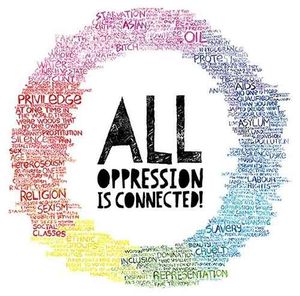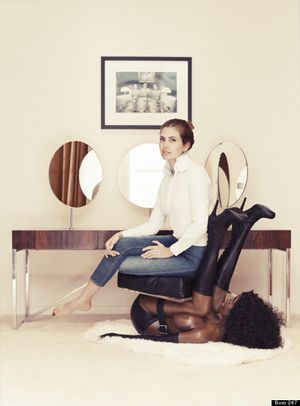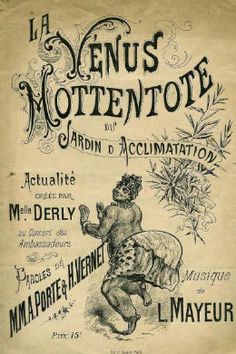Racialized Sexuality
Racialized sexuality can be defined as a sociological concept that refers to the critical analysis of the intersecting effects of race and sexuality. [1] Historically sustained racist and racialized thinking helped to develop theories categorizing people of colour as "the other" in relation to white-skinned people of European consent. [2] These beliefs work to construct identities of sexualized racism and stereotypes stem from histories of colonialism, imperialism, and wars that have taken place in white Western conquest of other lands and peoples. Its function is to uphold white supremacist patriarchal notions on sexual purity, protecting whiteness while demonizing the other.
Intersectionality

Intersectionality is the prevalent concept of racialized sexuality. Coined by Kimberle Crenshaw in 1989, intersectional feminism calls for the examination of gender in conjunction with race, as well as other traits including, but not limited to, health, religion, sexuality, social status, and economic status. These traits cannot be treated “as mutually exclusive categories of experience and analysis”.[3] Those are experience racialized sexism do not only have to experience discrimination based on gender, but also the compound discrimination of race. It is important to note here that by this notion, there is no "universal woman" and that experiences of sexism among women cannot be talked about generally as each women experiences it differently based on her unique social locations.
Whiteness
According to scholar Steve Garner, he presents these five arguments on Whiteness:
- 'White' is a marked racialised identity whose precise meanings derive from national racial regimes.
- Whiteness as an identity exists only in so far as other racialised identities, such as blackness, Asianness, etc., exist.
- Whiteness has been conceptualised over the century or so since it was first used, as terror, systemic supremacy, absence/invisibility, norms, cultural capital, and contingent hierarchies
- Whiteness is also a problematic, or an analytical perspective: that is, a way of formulating questions about social relations.
- The invocation of white identities may suspend other social divisions and link people who share whiteness to dominant social locations, even though the actors are themselves in positions of relative powerlessness.[4]
Historically, white women hold this position where they have self-control, respect, modesty, and purity. In contrast, all other racialized women serve to contrast this image.
Hegemonic Femininity

Hegemonic femininity[5] refers to a hiearchy of femininity that exists in society. The ideal feminine expression is white, heterosexual, middle-class, pretty. In contrast to this are transgressive women who are queer, trans, nonmonogamous; and marginalized women who are of colour, poor, immigrants, or with disabilities. By holding a standard expression of femininity above all others, any exemption to this standard by way of actions or other intersecting oppressions act to deny those women the same privileges the ideal woman is afforded.
When women do not fit this ideal, they are subject to various forms of social punishment, physical/symbolic/psychological violence, public scrutiny, objectification, or a hypersexualized pornographic gaze. Racialized individuals, in relation to the white ideal of sexuality, are in a position of a sort of double edged sword. They are pressured to subscribe to or aspire to the ideal sexuality in any way, but never quite achieve it , and in doing so, may experience other forms of beliefs such as internalized racism.
Gender Differences
There is a double standard in sexual behaviour between men and women. A man and woman that take part in the same amount of high sexual activity, will face vastly different attitudes.[6] Men are socially praised, whereas women are socially degraded. Examining this social degredation in terms of racialized sexuality, different races of women are put on variant levels.
In Espiritu's article "We Don't Sleep Around Like White Girls Do", the ideal Filipina woman is constructed from the communities conceptualization of white women. Embodying the moral integrity of the idealized ethnic community, immigrant women, particularly young daughters, are expected to comply with male-defined criteria of what constitutes "ideal" feminine virtues.[7] The men in this community, specifically the brothers of such females, take on a policing role. They constantly watch over and judge these women, ensuring conformity to the sexual ideal.[8]
Historical Background
Slavery

Institutionalized ideology’s construction of Women of colour’s sexuality as deviant has been used historically as well as in the present to perpetuate the commodification and exploitation of non-white female bodies. An early reference to racialized sexualization comes from the Saartjie Baartman case. She was orphaned in a commando raid ands sold to be put on for show all across Europe, with her showman earning profit from her body exhibitions. The fascination in her came from the fact that she had a large buttocks. She was made a part of a freak show exhibit, which both sexualized her body and treated her like an animal, or even an object. Though she did partake in a portion of the profits, her body was objectified for the ultimate goal of profit and fame. When she passed away her body was dissected and preserved with the purpose of being shown in a museum in France. In the 70's her body was removed from the museum and in 2002 it was sent to her hometown for a proper memorial. [9] [10] Portrayals of her are highly exagerrated and caricaturized, with her usually dressed in primitive clothing so as to emphasize and contrast her next to the "civilized" white woman.
The legacy of slavery has largely constructed beliefs and shaped perceptions of black women’s sexualities. Black male sexuality was constructed by white supremacy to be dangerous and savage-like, creating an image of a “predatory black rapist”. Black women were seen as immoral, easy and loose. These women were given the rold of a primitive sex object, thereby justifying their dehumanization, degrading practices, and sexual violation. As a result, the image ascribed was savage, hypersexual, and animalistic. Sexual stereotypes that emerged were that of the Jezebel, Sapphire, and Mammy.[11]
Colonialism
Colonization of the Americas required the systematic dehumanization of Indigenous nations that were settled there once the European invaders arrived. The women were subsequently seen as possessions and used accordingly for generations. By a hypersexual and barbaric image of the Indigenous woman, colonizers could justify any violence enacted upon them. Translating into how they are viewed currently, Aboriginal women are described as having a sexual allure that was is so desirable it is difficult to resist temptation, and often women are assaulted and raped as a result of this fetish. The harmful stereotypes of the squaw, the savage, and the native princess have contributed to the hypsexualization of Indigenous woman to this day. The appropriation of sacred Indigenous garments such as the headdress in the Victoria's Secret fashion show or music festivals are also another image that has contributed to this violence.
Indigenous Women of Canada
“Aboriginal women aged fifteen or older are three and a half times more likely to be victims of violence than non-Aboriginal women”. [12] In Canada, Indigenous women are targets of sexual violence. They are heavily victimized and degraded due to the “double-burden” they carry of discrimination due to both their race and their sex. [13] In Vancouver’s Downtown Eastside, Valentine’s Day is dedicated to the memories of the hundreds of missing and murdered women in Canada. Aboriginal women face extreme discrimination as well as violence directed at them due to their intersecting racial and sexual characteristics.
Imperialism
The role of Western imperialism in Asia has constructed much of the stereotypes of Asian women. Histories of Western political, military, and economic domination have worked to produce a sexual stereotype that is submissive to the white male in this context. She exemplifies hypersexuality as well as hyper-heterosexuality as male-centered and male-dominated, as the "perfect complement to the exaggerated masculinity of the White Man, existing solely to serve men and be sexually consumed by them" [14]
Model Minority
Woan notes that "The dominant class often pits one marginalized group against another, compelling one group to feel inadequate in comparison to the other for not possessing a certain attribute or behaving in a manner that pleases the dominant class. This strategy incites enmity between the two groups, setting them as rivals who ought to battle for the approval of the dominant class. In the end, though, this strategy only serves to both discipline and maintain the supremacy of the dominant class" [14]. The model minority stereotype referring to Asians in North America is one example of this process, where in the relative economic success of Asians (as a result of immigration policies) is used to blame other groups, such as African Americans in the United States as causing their own problems and protesting them too much. This notion is further deployed to uphold the hypersexualized Asian woman sterotype against that of the white woman. These racially sexualized women are particularly valued in a sexist society as they serve as an antithesis to the liberated and assertive career woman of the West, as they are stupid, willing, submissive, and docile. Sexual stereotypes surrounding Asian women are the dragon lady and geisha girl.
Pop Culture and Media
Black Promiscuity
In popular culture, Black hypersexuality and hypermasculinity are ever present. [15] Media often uses the marketing tactic of the "ideal self" to sell their products. They depict societies view of 'ideal people' in their ads, saying to the consumer that if they purchase the product or become like the celebrities, they too can enjoy that lifestyle and body.
For Black Men this takes the form of hypermasculinity. Black men statistically consume high levels of professional sports. [16] These athletes are used as the 'ideal' being portrayed for these men. Media's depiction of Black Men tends to be highly fit and muscular. Looking at the lives of some famous Black athletes, such as Wilt Chamberlin, one can see that the representation of these men are also hypersexualized. Chamberlain said that in his life up to that date he had slept with 20,000 women.[17]
In the music industry, Black Women are hypersexualized. Looking at music videos such as Nicki Minaj's "Anaconda" or Jason Derulo's "Talk Dirty to Me", the hypersexualization of Women of Colour is evident. These videos are incredibly popular, ensuring the continued sexualized view of Black Women. Nicki Minaj's video alone "received 19.6 million views the first day it was released showing that Nicki Minaj is a popular American figure".[10]
Double Standards and Appropriation
White female sexual explicitness has been deraciazlied by society generally, while at the same time, strongly accentuating in contrast, what is perceived as Black female promiscuity and immodesty. Ariel Levy argues in a perceived “post-feminist” world, explicit female sexuality is seen as both empowering and liberating. [18] Often-times the faces of these expressions however, are white. Women of colour who always have the negative “slut” association with them do not afford the privilege to express their sexuality and celebrate their bodies freely without receiving criticism. Miley Cyrus appropriating African-American styling and using black women’s bodies as props will be met with defense in the name of slut-shaming, while Beyonce will never gain acceptance in the feminist club despite having an all-female band and singing songs empowering women because she lacks a scholarly background and is “too much” as a performer. Some women’s actions and bodies will always be policed no matter what because of their intersectional oppressions.
Feminized masculinity
While all men of colour face racist sexualized stereotype, Asian men in particular are characterized as effeminate, weak, nonthreatening, and often asexual. Portrayals in the media often follow stereotypical tropes: kung fu master, socially awkward nerd, perpetual foreigner. In contrast to the hypersexualized Asian women, the Asian man is portrayed to be highly asexual. Accordingly to their position in the social structure, Asian men are positioned as being more feminine in the Western discourse of hegemonic masculinity so as to never achieve perfect male status. [19]
Language
Bitch
The term "Bitch" is a word that has evolved to be associated with women. "Bitch" is a commonly used slang word that has several meanings and interpretations. The term can simply mean “female dog”, however, it can also be used as an insult towards a person who is malicious, unreasonable, intrusive, aggressive and unpleasant. It is, however, possible that a women referred to as a "bitch" can bring positive reinforcements. The word "bitch" has been adopted by popular female rappers that refer to themselves as "bitches" in a sort self-empowerment role. In society, sex and power are interrelated. and so to "understand how a word such as “bitch” could be perceived as empowering, it is first necessary to recognize that language is not fixed. Rather, it is a battleground where words and their meanings are the center of contestation"(Celious 2002, p. 91-92). [20]
Status
"In dominant constructions of sexuality sexual experience is positioned as a marker of masculine status: The more sex you have had, with the largest number of women the more of a man you are" (Flood 2002, p. 24). Looking at men, "boys and young men's lives are shaped by powerful social and sexual relations"(Flood 2002, p. 24). It is evident is that young males are looking in their peer groups to achieve "Manhood points"(Flood 2002, p. 24). Boys are known to have the ability to gain their social status by demonstrating their ability in stereotypical masculine activities such as physical skills and heterosexual sexual achievement.[21]
References
- ↑ Racialized Gender. (2007). In Blackwell Encyclopedia of Sociology. Retrieved from: http://www.blackwellreference.com/subscriber/uid=1754/tocnode?id=g9781405124331_yr2013_chunk_g978140512433124_ss1-12
- ↑ Sexuality, Racialized. (2013). In "Encyclopedia of Race and Racism". Retrieved from: http://go.galegroup.com.ezproxy.library.ubc.ca/ps/i.do?id=GALE%7CCX4190600402&sid=summon&v=2.1&u=ubcolumbia&it=r&p=GVRL&sw=w&asid=3ce42caa59753ff043f99db798eee2e4
- ↑ Kimberle Crenshaw "Demarginalizing the intersection of race and sex: A black feminist critique of antidiscrimination doctrine, feminist theory and antiracist politics", University of Chicago Legal Forum (1989): 139-167.
- ↑ Garner, Steve. (2007) "Whiteness: An Introduction" Routledge.
- ↑ Chou, Rosalind. (2012) "Asian American Sexual Politics: The Construction of Race, Gender, and Sexuality." Rowman & Littlefield Publishers.
- ↑ Jackson, Megan. (2011) "Sluts versus studs or ladies versus losers? Is the sexual double standard evident when individuals refuse casual sex?" The University Of Queensland.
- ↑ Yen Le, Espiritu. (2001) ""We Don't Sleep Around Like White Girls Do": Family, Culture, and Gender in Filipina American Lives" University Of Chicago press. p. 415-440 Vol. 26, No.2
- ↑ Yen Le, Espiritu (2003) "Home Bound: Filipino American Lives across Cultures, Communities, and Countries" University of California Press p. 164-170
- ↑ Magubane, Z. (2001). Which bodies matter? Feminism, poststructuralism, race, and the curious theoretical odyssey of the “Hottentot Venus”. Gender & Society, 15(6), 816-834.
- ↑ 10.0 10.1 Reduced To Only a Body, (2014) In "Objectification Of Black Womens body (18th Century) Sara Baartman.
- ↑ Townsend, Tiffany G. et al. "I'm no Jezebel; I Am Young, Gifted, and Black: Identity, Sexuality, and Black Girls." Psychology of Women Quarterly 34.3 (2010): 273. Web.
- ↑ Anderson, A. (n.d.). Violence against Aboriginal women. Retrieved from http://inequalitygaps.org/first-takes/racism-in-canada/violence-against-aboriginal-women/.
- ↑ Anderson, K. (2013). The Construction of a Negative Identity. Gender and Women's Studies in Canada: Critical Terrain, 269.
- ↑ 14.0 14.1 Woan, Sunny. (2008). A Theory of Asian Feminist Jurisprudence. Scholarly Commons. Washington and Lee University School of Law, 2008. Web. Retrieved from http://scholarlycommons.law.wlu.edu/cgi/viewcontent.cgi?article=1243&context=crsj.
- ↑ Slatton C, Brittany. Spates, Kamesha. (2014) "Hyper Sexual, Hyper Masculine?: Gender, Race and Sexuality in the Identities of Contemporary Black Men".
- ↑ Slatton C, Brittany. Spates, Kamesha. (2014) "Hyper Sexual, Hyper Masculine?: Gender, Race and Sexuality in the Identities of Contemporary Black Men.
- ↑ Deezen, Eddie. "Did Wilt Chamberlain really sleep with 20,000 women? Retrieved from http://mentalfloss.com/article/12310/did-wilt-chamberlain-really-sleep-20000-women
- ↑ Levy, Ariel. (2005) "Female Chauvinist Pigs: Women and the Rise of Raunch Culture. New York: Free Press.".
- ↑ Chou, Rosalind. (2012) "Asian American Sexual Politics : The Construction of Race, Gender, and Sexuality. Roman & Littlefield Publishers.
- ↑ Celious K, Aaron. (2002). "How “Bitch” Became A Good Thing – Or, At Least Not That Bad". Westview Press.
- ↑ Flood, Michael (2002) "Pathways to Manhood: The social and sexual ordering of young men's lives". Victorian Branch Publication.